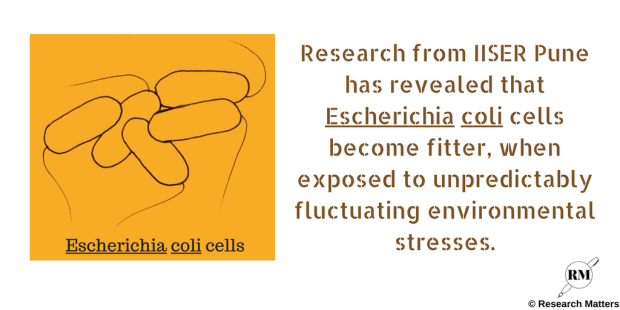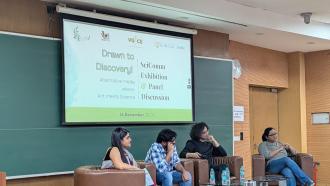
Photo: Research Matters
Escherichia coli, a poster boy for microbiology research and the notorious bacteria that causes stomach infections, might soon be an unusual source of inspiration for us, humans, for learning how to handle stress! A new study by scientists at the Indian Institute of Science, Education and Research (IISER) Pune, has revealed, for the first time, that E. coli cells become more sturdy and fit when exposed to unpredictably fluctuating environments containing high levels of salts or chemicals, or having extreme pH values. Led by Prof. Sutirth Dey, the study aims to investigate the evolution of fitness and the costs incurred by the bacteria in this process.
But, why should there be a cost to becoming fitter, in the first place?
“A thumb rule in evolution is the concept of trade-off, which means that if you become good at something, there is a cost that you would have to pay somewhere else. We just wanted to find out these costs,” explains Prof. Dey talking about the motivation behind this study.
Most of the previous evolutionary studies on bacteria have examined bacterial response to a single environmental stress factor like the presence of a chemical agent or a salt, a change in the pH of its environment, or a fluctuation in the temperature of its surroundings. However, in nature, every single bacterium has to not only deal with randomly fluctuating levels of each of these, but also multiple such stresses simultaneously. The current research is one of the first such studies to take into account both the unpredictable fluctuations of these stresses and their effect when they act simultaneously.
The researchers took identical cultures of bacterial cells and exposed them to complex unpredictably fluctuating environments, as well as a constant stress environment, for around 900 generations.
“In this particular experiment, we threw unpredictable fluctuations and environmental complexity together at the bacteria. And in principle, whatever we are seeing can come due to either one of the factors. Or there might even be an interaction between these factors”, says Prof. Dey.
The results of the study came as a surprise to the researchers as they could not pinpoint a single incidence of a tradeoff or cost that the selected bacteria incurred across environments. Prof. Dey opines that the consequence of not following the thumb rule of evolution is that these bacteria will eventually become good at facing multiple stresses. “If you think about this in another way, this is exactly how a super bug is defined” he exclaims. “Typically people think of superbugs as bacteria that will be able to face a large number of antibiotics, but you can also think of superbugs as something which are highly fit under may different stresses”, he explains.
The researchers measured the fitness of the bacteria to determine the evolutionary costs incurred. “Fitness of an organism can be thought of as the number of offspring it leaves behind. But more often than not, it is very difficult to measure the fitness of an organism directly, as it is a composite of so many factors taken together. Thus, in evolutionary biology, fitness is very often measured in terms of other factors affecting the reproductive success of the organism”, says Prof. Dey, explaining the methodology used in this study.
Prof. Dey feels that the biggest question this study raises is about the absence of a trade-off in these bacteria when facing multiple fluctuating environments. “The trade-offs are very likely happening across other measures of fitness, which were not investigated in our study. So, it’s quite possible that trade-offs exist, but we aren’t yet looking at the correct place”, he adds.
This study raises a lot of important questions about the way evolutionary studies of microbial fitness are conducted in the laboratory and challenges our understanding of the trade-offs in the evolution of every adaptive trait. Further such studies will go a long way towards improving our understanding of microbial evolution as it occurs in nature, rather than in laboratory settings.

























